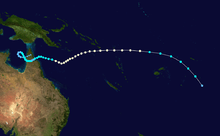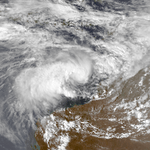1992–93 Australian region cyclone season
1992–93 Australian region cyclone season
| |
| Season summary map |
| First system formed |
17 December 1992 |
| Last system dissipated |
16 May 1993 |
| Strongest storm1 |
Oliver – 950 hPa (mbar), 165 km/h (105 mph) (10-minute sustained) |
| Tropical lows |
6 |
| Tropical cyclones |
8 |
| Severe tropical cyclones |
4 |
| Total fatalities |
0 |
| Total damage |
$950 million (1992 USD) |
| 1Strongest storm is determined by lowest pressure |
Australian region tropical cyclone seasons
1990–91, 1991–92, 1992–93, 1993–94, 1994–95 |
| Related articles |
|
|
The 1992–93 Australian region cyclone season was a below average Australian cyclone season. It was also an event in the ongoing cycle of tropical cyclone formation. It ran from 1 November 1992 to 30 April 1993. The regional tropical cyclone operational plan also defines a tropical cyclone year separately from a tropical cyclone season, and the "tropical cyclone year" ran from 1 July 1992 to 30 June 1993.
Tropical cyclones in this area were monitored by four Tropical Cyclone Warning Centres (TCWCs): the Australian Bureau of Meteorology in Perth, Darwin, and Brisbane; and TCWC Port Moresby in Papua New Guinea.
Storms
Tropical Cyclone Ken
| Category 1 tropical cyclone (Australian scale) |
| Tropical storm (SSHWS) |
|
|
| Duration |
17 December – 23 December |
| Peak intensity |
75 km/h (45 mph) (10-min) 990 hPa (mbar) |
Tropical Cyclone Ken existed from 17 December to 23 December.[1]
Severe Tropical Cyclone Nina
| Category 3 severe tropical cyclone (Australian scale) |
| Category 1 tropical cyclone (SSHWS) |
|
|
| Duration |
21 December – 1 January |
| Peak intensity |
140 km/h (85 mph) (10-min) 960 hPa (mbar) |
Nina formed on December 21, 1992, the storm reached Category 1 status before making landfall in northern Queensland, then Nina moved eastward, reaching Category 3 status before becoming an extratropical cyclone on January 4, 1993.[2]
Severe Tropical Cyclone Lena
| Category 3 severe tropical cyclone (Australian scale) |
| Tropical storm (SSHWS) |
|
|
| Duration |
22 January – 2 February |
| Peak intensity |
120 km/h (75 mph) (10-min) 972 hPa (mbar) |
Severe Tropical Cyclone Lena existed from 22 January to 2 February.
Severe Tropical Cyclone Oliver
| Category 4 severe tropical cyclone (Australian scale) |
| Category 4 tropical cyclone (SSHWS) |
|
|
| Duration |
3 February – 14 February |
| Peak intensity |
165 km/h (105 mph) (10-min) 950 hPa (mbar) |
Severe Tropical Cyclone Oliver existed from 3 February to 14 February.
Severe Tropical Cyclone Polly
| Category 3 severe tropical cyclone (Australian scale) |
|
|
| Duration |
25 February – 28 February |
| Peak intensity |
140 km/h (85 mph) (10-min) 955 hPa (mbar) |
Severe Tropical Cyclone Polly formed east of Australia. On February 28, Polly exited TCWC Brisbane's area of responsibility into the South Pacific.
Tropical Cyclone Roger
| Category 2 tropical cyclone (Australian scale) |
|
|
| Duration |
12 March – 20 March |
| Peak intensity |
110 km/h (70 mph) (10-min) 980 hPa (mbar) |
Tropical Cyclone Roger peaked as a category 2 cyclone on March 15. On March 20, Roger exited the Australian region into the South Pacific.
Tropical Cyclone Monty
| Category 1 tropical cyclone (Australian scale) |
| Tropical storm (SSHWS) |
|
|
| Duration |
6 April – 15 April |
| Peak intensity |
75 km/h (45 mph) (10-min) 992 hPa (mbar) |
Tropical Cyclone Monty existed from 6 April to 15 April.
Tropical Cyclone Adel
| Category 1 tropical cyclone (Australian scale) |
| Tropical storm (SSHWS) |
|
|
| Duration |
11 May – 16 May |
| Peak intensity |
65 km/h (40 mph) (10-min) |
Adel lasted from 11–16 May 1993. During its life, it passed over Bougainville Island and near Goodenough Island, leaving two drowned and a total of at least 15 missing. Leaves were blown from trees, and 345 houses were destroyed, along with a radio tower that was bent over.[3]
See also
References















